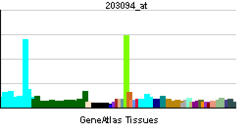MAD2L1BP
| MAD2L1 binding protein | |||||||||||||
|---|---|---|---|---|---|---|---|---|---|---|---|---|---|
| |||||||||||||
| Identifiers | |||||||||||||
| Symbols | MAD2L1BP ; CMT2 | ||||||||||||
| External IDs | MGI: 1913841 HomoloGene: 11990 GeneCards: MAD2L1BP Gene | ||||||||||||
| |||||||||||||
| RNA expression pattern | |||||||||||||
 | |||||||||||||
| More reference expression data | |||||||||||||
| Orthologs | |||||||||||||
| Species | Human | Mouse | |||||||||||
| Entrez | 9587 | 66591 | |||||||||||
| Ensembl | ENSG00000124688 | ENSMUSG00000034509 | |||||||||||
| UniProt | Q15013 | Q9DCX1 | |||||||||||
| RefSeq (mRNA) | NM_001003690 | NM_025649 | |||||||||||
| RefSeq (protein) | NP_001003690 | NP_079925 | |||||||||||
| Location (UCSC) | Chr 6: 43.6 – 43.61 Mb | Chr 17: 46.15 – 46.15 Mb | |||||||||||
| PubMed search | |||||||||||||
MAD2L1-binding protein is a protein that in humans is encoded by the MAD2L1BP gene.[1][2][3]
The protein encoded by this gene was identified as a binding protein of the MAD2 mitotic arrest deficient-like 1 (MAD2/MAD2L1). MAD2 is a key component of the spindle checkpoint that delays the onset of anaphase until all the kinetochores are attached to the spindle. This protein may interact with the spindle checkpoint and coordinate cell cycle events in late mitosis. Alternatively spliced transcript variants encoding distinct isoforms have been observed.[3]
Interactions
MAD2L1BP has been shown to interact with TRIP13.[4][5]
References
- ↑ Nagase T, Miyajima N, Tanaka A, Sazuka T, Seki N, Sato S, Tabata S, Ishikawa K, Kawarabayasi Y, Kotani H et al. (Jul 1995). "Prediction of the coding sequences of unidentified human genes. III. The coding sequences of 40 new genes (KIAA0081-KIAA0120) deduced by analysis of cDNA clones from human cell line KG-1". DNA Res 2 (1): 37–43. doi:10.1093/dnares/2.1.37. PMID 7788527.
- ↑ Habu T, Kim SH, Weinstein J, Matsumoto T (Nov 2002). "Identification of a MAD2-binding protein, CMT2, and its role in mitosis". EMBO J 21 (23): 6419–28. doi:10.1093/emboj/cdf659. PMC 136962. PMID 12456649.
- ↑ 3.0 3.1 "Entrez Gene: MAD2L1BP MAD2L1 binding protein".
- ↑ Rual, Jean-François; Venkatesan Kavitha, Hao Tong, Hirozane-Kishikawa Tomoko, Dricot Amélie, Li Ning, Berriz Gabriel F, Gibbons Francis D, Dreze Matija, Ayivi-Guedehoussou Nono, Klitgord Niels, Simon Christophe, Boxem Mike, Milstein Stuart, Rosenberg Jennifer, Goldberg Debra S, Zhang Lan V, Wong Sharyl L, Franklin Giovanni, Li Siming, Albala Joanna S, Lim Janghoo, Fraughton Carlene, Llamosas Estelle, Cevik Sebiha, Bex Camille, Lamesch Philippe, Sikorski Robert S, Vandenhaute Jean, Zoghbi Huda Y, Smolyar Alex, Bosak Stephanie, Sequerra Reynaldo, Doucette-Stamm Lynn, Cusick Michael E, Hill David E, Roth Frederick P, Vidal Marc (Oct 2005). "Towards a proteome-scale map of the human protein-protein interaction network". Nature (England) 437 (7062): 1173–8. doi:10.1038/nature04209. PMID 16189514.
- ↑ Stelzl, Ulrich; Worm Uwe, Lalowski Maciej, Haenig Christian, Brembeck Felix H, Goehler Heike, Stroedicke Martin, Zenkner Martina, Schoenherr Anke, Koeppen Susanne, Timm Jan, Mintzlaff Sascha, Abraham Claudia, Bock Nicole, Kietzmann Silvia, Goedde Astrid, Toksöz Engin, Droege Anja, Krobitsch Sylvia, Korn Bernhard, Birchmeier Walter, Lehrach Hans, Wanker Erich E (Sep 2005). "A human protein-protein interaction network: a resource for annotating the proteome". Cell (United States) 122 (6): 957–68. doi:10.1016/j.cell.2005.08.029. ISSN 0092-8674. PMID 16169070.
Further reading
- Hoja MR, Wahlestedt C, Höög C (2000). "A visual intracellular classification strategy for uncharacterized human proteins". Exp. Cell Res. 259 (1): 239–46. doi:10.1006/excr.2000.4948. PMID 10942595.
- Suzuki H, Fukunishi Y, Kagawa I et al. (2001). "Protein–Protein Interaction Panel Using Mouse Full-Length cDNAs". Genome Res. 11 (10): 1758–65. doi:10.1101/gr.180101. PMC 311163. PMID 11591653.
- Strausberg RL, Feingold EA, Grouse LH et al. (2003). "Generation and initial analysis of more than 15,000 full-length human and mouse cDNA sequences". Proc. Natl. Acad. Sci. U.S.A. 99 (26): 16899–903. doi:10.1073/pnas.242603899. PMC 139241. PMID 12477932.
- Mungall AJ, Palmer SA, Sims SK et al. (2003). "The DNA sequence and analysis of human chromosome 6". Nature 425 (6960): 805–11. doi:10.1038/nature02055. PMID 14574404.
- Xia G, Luo X, Habu T et al. (2005). "Conformation-specific binding of p31comet antagonizes the function of Mad2 in the spindle checkpoint". EMBO J. 23 (15): 3133–43. doi:10.1038/sj.emboj.7600322. PMC 514937. PMID 15257285.
- Gerhard DS, Wagner L, Feingold EA et al. (2004). "The Status, Quality, and Expansion of the NIH Full-Length cDNA Project: The Mammalian Gene Collection (MGC)". Genome Res. 14 (10B): 2121–7. doi:10.1101/gr.2596504. PMC 528928. PMID 15489334.
- Stelzl U, Worm U, Lalowski M et al. (2005). "A human protein-protein interaction network: a resource for annotating the proteome". Cell 122 (6): 957–68. doi:10.1016/j.cell.2005.08.029. PMID 16169070.
- Rual JF, Venkatesan K, Hao T et al. (2005). "Towards a proteome-scale map of the human protein-protein interaction network". Nature 437 (7062): 1173–8. doi:10.1038/nature04209. PMID 16189514.
- Yun MY, Kim SB, Park S et al. (2007). "Mutation analysis of p31comet gene, a negative regulator of Mad2, in human hepatocellular carcinoma". Exp. Mol. Med. 39 (4): 508–13. doi:10.1038/emm.2007.56. PMID 17934339.